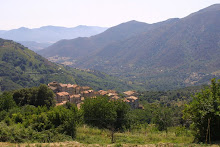The Old city area viewed from the sky

mercredi 24 février 2010
THE VIRTUAL SHANGHAI BLOG HAS MOVED
Lyon-Shanghai, 24 February 2010
mercredi 10 février 2010
A 1927 full aerial view of the Shanghai area
mardi 2 février 2010
1932 Sino-Japanese conflict in Shanghai: Maps of the ceasifire agreement
I found a partial set of the original maps (8/14) signed by the Chinese and Japanese delegates, as well as by the official witnesses to the agreement at the U.K. National Archives. These are valuable documents as they show the local topography at a scale of 1/5000, including a unique cover of the Zhabei area. An assemblage of the available maps can be found on Virtual Shanghai (Map ID 774). Individual maps are also available under Map ID 765-772. One easy way to find the whole set is to search under "Hu bei dixing zongtu" in the search box for 'Transliteration'.
The missing maps must be somewhere in the vaults of the U.K. National Archives that holds a huge collection of maps (11 million items). Unfortunately, large numbers have not yet been catalogued. Further research should lead to their eventual retrieval.
jeudi 1 octobre 2009
International Workshop on history and visual documents
The October 2009 workshop will encourage participants to tackle a bit more issues of methodology and narrative. Its broad theme -- Visual, Representations, Materiality and Narratives -- however is meant to suggest an open exploration of the various dimensions visual sources entail for historical knowledge. The historical discipline is rooted in the careful analysis of textual documents through elaborate methods crafted by generations of historians. The pre-eminence of the written world has found its manifestation in the reliance on archives as the primary material of the historian. These foundations have been shaken by post-modern critics who argued that archives were like all other historical documents, a form of narrative that offered no more guarantee of objectivity than other productions such as the press or even literary texts. This challenge has redefined the way historians ‘think’ and mobilize their sources in the reconstruction of the past.
The study of visual documents goes beyond the field of history, of course. It is a complex field that takes all forms of visual production and representation as its targets of investigation. The production and circulation of visual documents generate for any given period a particular visual culture that sets the environment within which individual documents (whatever their nature) has to be approached. Who does what and when and how does it become visual, in what historical relations do specific images stand to others, what is the social life of an image, what is the relationship between a social actor and the image? Thus the visual offers itself as both material and representational. It is to understand this duality and its implications and to find answers to these types of questions that scholars will get together at the 2009 workshop on history & images.
mercredi 16 septembre 2009
Shanghai Stock Exchange Project
"The project is about Chinese capital markets (1870-1940). The Shanghai Stock Exchange History Research Project is an on-going research effort by the International Center of Finance to collect price and dividend information on stocks that were listed in the Shanghai Stock Exchange (SSE) during the nineteenth and beginning of the twentieth centuries."
"The market for securities trading in Shanghai begins in late 1860s. More specifically, in June 1866, a list of thirteen companies, including the Hong Kong & Shanghai Banking Corporation, appeared in a local newspaper under the 'Shares and Stocks' section. According to the English newspaper in Shanghai, The North-China Herald this is the time that a 'regular system of dealing in Shares sprang up'. The operation of Shanghai stock exchange comes to a halt on December 8, 1941 when the Japanese took hold of the International Settlement. After the war ended, China assumed full control over Shanghai, the legal privilege and means of enforcing financial contracts for foreign businessmen had gone. The Shanghai Stock Exchange, as a foreign share brokers' association, never reopened again."
The web site provides downlable annual price data for all the securities listed in the Shanghai Stock Exchange from 1870 to 1940, as well as constructed indexes for the Shanghai Stock Exchange, which can be also be downloaded. This is a very rare project in Chinese economic history.
mercredi 26 août 2009
New Japanese Books on Shanghai
The first one is the edited volume published by the Japanese Association for Research on Shanghai History (日本上海史研究会), a major and regular contributor to Shanghai history through a multi-volume series. The last volume is the edited proceedings of a conference held in 2008 in Tokyo: Kenkoku zengo no Shanhai 建國前後の上海 (Shanghai around the time of the birth of the P.R.C.). The 15-contribution volume examines a variety of issues the city met with during the transition period before and after the civil war.
The second volume is a much awaited study of the Japanese community in Shanghai before 1949. It is authored by Prof. Hirofumi Takatsuna 高綱博文, the leading figure of Shanghai studies in Japan: , 'Kokusai toshi' Shanhai no naka no nihonjin '國際都市' 上海のなかの日本人. This is the most thorough study of one of the most influential foreign communities in modern Shanghai.
mardi 21 juillet 2009
An artistic rendering of the Shanghai Bund
Among his rich body of works, Simon Fieldhouse produced a complete series of drawings of the historical buildings on the Shanghai Bund, with a skyline of the whole Bund and an accurate numbering of the individual buildings.
The series is available on his web site: http://www.simonfieldhouse.com/shanghai.htm
This is a wonderful resource for art historians and historians alike. It provides elegant sketches of each of the buildings that were once the proud display of the companies that built them. It forms a unique collection of visual materials about the Shanghai Bund.
